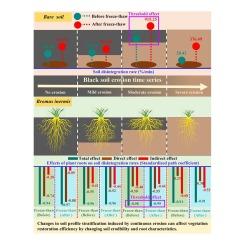Time-sensitive effects of vegetation restoration on slowing down soil erosion: Evidence from Northeastern China with Mollisols
IF 5.4
1区 农林科学
Q1 GEOSCIENCES, MULTIDISCIPLINARY
引用次数: 0
Abstract
The loss of fertile topsoil caused by erosion leads to the relative change of soil profile configuration, which consequently leads to a series of changes in soil properties. These changes will theoretically affect vegetation restoration efficiency, resulting in a threshold effect of soil erodibility and vegetation restoration effects as soil erosion continues. In this study, we simulated the decrease of the topsoil layer caused by erosion (that is, the thickness of the black soil layer was 30 cm, 20 cm, 10 cm, and 0 cm in order) by filling pots with different proportions of black soil and deposition layer soil to represent the time series of soil erosion: no erosion, mild erosion, moderate erosion and severe erosion. The soil disintegration characteristics in the time series of black soil erosion with and without vegetation (Bromus inermis) were compared, and the response of this process to seasonal freeze–thaw was further considered. We found that in the absence of vegetation, the disintegration rate was the highest at moderate erosion with the intensification of black soil erosion. That is, moderately eroded black soils had an even higher soil erodibility than severely eroded black soils. Vegetation can significantly reduce soil disintegration rates and enhance soil resistance to seasonal freeze–thaw, this is highly dependent on the combined effects of soil stratification and subsequent root characteristics. Our findings revealed that both soil erodibility and vegetation restoration efficiency of degraded stratified soil have threshold effects as soil erosion degree increases. In other words, the effects of vegetation restoration on preventing soil erosion are time-sensitive. Moreover, seasonal freeze–thaw can also affect soil erodibility and vegetation restoration efficiency by changing soil properties and root characteristics. These findings may help determine effective vegetation restoration strategies in areas with similar soil types, profiles, and bioclimatic characteristics to the black soil areas.

植被恢复对减缓水土流失的时间敏感效应:来自中国东北地区软质土壤的证据
水土流失造成肥沃表土流失,导致土壤剖面结构发生相对变化,进而引发一系列土壤性质变化。从理论上讲,这些变化会影响植被恢复效率,导致土壤可侵蚀性和植被恢复效果随着土壤侵蚀的持续而出现阈值效应。在本研究中,我们通过在盆中填充不同比例的黑土和沉积层土壤来模拟水土流失造成的表土层减少(即黑土层厚度依次为 30 厘米、20 厘米、10 厘米和 0 厘米),以表示土壤侵蚀的时间序列:无侵蚀、轻度侵蚀、中度侵蚀和严重侵蚀。我们比较了有植被(Bromus inermis)和无植被黑土侵蚀时间序列中的土壤崩解特征,并进一步考虑了这一过程对季节性冻融的响应。我们发现,在没有植被的情况下,随着黑土侵蚀的加剧,中度侵蚀时的崩解率最高。也就是说,中度侵蚀的黑土比严重侵蚀的黑土具有更高的土壤侵蚀性。植被可以大大降低土壤的崩解率,增强土壤对季节性冻融的抵抗力,但这在很大程度上取决于土壤分层和后续根系特征的综合影响。我们的研究结果表明,随着土壤侵蚀程度的增加,退化分层土壤的可侵蚀性和植被恢复效率都具有临界效应。换句话说,植被恢复对防止土壤侵蚀的效果具有时间敏感性。此外,季节性冻融也会通过改变土壤性质和根系特征来影响土壤可侵蚀性和植被恢复效率。这些发现可能有助于在土壤类型、剖面和生物气候特征与黑土区相似的地区确定有效的植被恢复策略。
本文章由计算机程序翻译,如有差异,请以英文原文为准。
求助全文
约1分钟内获得全文
求助全文
来源期刊

Catena
环境科学-地球科学综合
CiteScore
10.50
自引率
9.70%
发文量
816
审稿时长
54 days
期刊介绍:
Catena publishes papers describing original field and laboratory investigations and reviews on geoecology and landscape evolution with emphasis on interdisciplinary aspects of soil science, hydrology and geomorphology. It aims to disseminate new knowledge and foster better understanding of the physical environment, of evolutionary sequences that have resulted in past and current landscapes, and of the natural processes that are likely to determine the fate of our terrestrial environment.
Papers within any one of the above topics are welcome provided they are of sufficiently wide interest and relevance.
 求助内容:
求助内容: 应助结果提醒方式:
应助结果提醒方式:


